|
|
Post by shadowdragon on Jul 15, 2010 0:04:35 GMT
|
|
|
|
Post by shadowdragon on Jul 15, 2010 1:18:57 GMT
|
|
|
|
Post by DAG on Jul 15, 2010 7:06:28 GMT
Wow Audra, what a lovely huge area for a veg. patch, makes me feel silly with my little 8 X 6 foot greenhouse! ;D
But I am not aiming at being self sufficient, which is just as well!
Everything looks so well organized and healthy, your ground must be very fertile, what do you add to the soil each year?
|
|
|
|
Post by kedigato on Jul 15, 2010 8:09:07 GMT
What a wonderful veggie patch!    You obviously enjoy it, even though it is all a lot of work, otherwise it wouldn't look so good. I note that you have straw everywhere. I guess for several reasons - to keep the soil moist, keep the cucumbers off the ground and save them from rotting and to keep the slugs away. |
|
|
|
Post by shadowdragon on Jul 15, 2010 17:23:54 GMT
Kansas has very good soil to begin with which helps. After we till the garden under in the fall, we put all of the chicken litter there, the rabbit cage leavings and the stall cleanings into it. We stop piling that in there towards the end of January and then till it again in early march.
The straw is actually hay which works a lot better than straw. Its not a slippery to walk on, composts down better, and doesn't deposite random wheat seeds all over the place. We actually use it for weed control. Nothing grows better or has deeper roots in Kansas than the weeds. So after we have planted and everything is growing good, we lay a thick layer of wet newspaper down and then spread hay over that. The hay keeps the newspaper fron blowing away in the Kansas wind after it dries and then it also has all of the other benifits of keeping the veggies off the ground.It is great at preventing weeds which is good because it is way to hot here to spend all day trying to hoe the darn things out of the ground.
And Dag, I would LOVE to have your green house. Especially for seed starting and winter growing.
|
|
|
|
Post by DAG on Jul 15, 2010 19:51:57 GMT
Thank you for the detailed explanation Audra, sounds like you have a good system on the basis of Permaculture and looks to be working well.
Is there a problem with having a small greenhouse, would it take off in a Tornado or get too hot in your temperatures. I imagine it could work quite well if you sited it in the shade of some trees and anchored it down to a decent base. Also be close enough to the house to be supplied with electricity and water.
|
|
|
|
Post by shadowdragon on Jul 15, 2010 21:34:53 GMT
A small green house would work fine here as long it was well anchored, well ventilated and in the summer was able to take advantage of afternoon shade. And of course, like you said, be close to the house for electricity and such. In a tonado, a house made of a bricks isn't safe. Only reinforced concrete is safe.
I should also mention that in the fall we till the newspaper and hay under.
We used to have a root vegetable patch, but we are working on putting all the root veggies (potatoes,carrots,parsnips, and onion) into containers to make it easier to harvest them.
|
|
|
|
Post by DAG on Jul 16, 2010 5:45:55 GMT
I would have thought that you would need an awful lot of containers in your circumstances, surely a raised bed would be simpler and cheaper. Also less bending for weeding and harvesting than being at ground level as with containers.
Not sure how that would work in your weather though! There again it would be the same problem with containers. Also if you get very cold temperatures at night, containers mean very exposed routes.
My problem with containers is that the insects like slugs etc. tend to go for these as it is always filled with nice soft compost as opposed to our heavy clay soil. So that means that the foxes and badgers dig holes in your containers to get at them! We get squirrels as well but not rabbits, must be very different in your circumstances?
|
|
|
|
Post by kedigato on Jul 16, 2010 7:50:24 GMT
I think DAG is right, raised beds would be the ideal thing instead of containers and you obviously have the space for some nice big ones. How big is your plot, it looks huge.
Ah, pumpkins! you can make some lovely soup with them (also zucchini) and wonderful jam, mmhhhhh!! I won't be making any this year unless I go out and buy the veggies.
|
|
|
|
Post by DAG on Jul 16, 2010 11:31:40 GMT
;D Hark at us, armchair gardeners, please excuse our questioning Audra but just puting ourselves in your situation, you obviously know your environment better than we do, just interested that's all?
|
|
|
|
Post by kedigato on Jul 16, 2010 12:11:06 GMT
DAG, now our game is up! Did you really have to let on that we are not proper gardeners? ;D ;D ;D
|
|
|
|
Post by shadowdragon on Jul 16, 2010 16:09:03 GMT
Raised beds would be lovely but I would rather have them for green beans and cucumbers,lol. We want the containers because then we can just dump them out when its time to harvest the roots veggies. We had a regular in the ground root veggie patch and its a pain to harvest. You would not believe how deep parsnips can go.
Slugs are not usually an issue here. Probably because of the extreme heat.Our squirrels never seem interested in the garden. We do have cottontails that try to munch on the bean. Taking one of the dogs through the garden helps keep the them away. When we have a persistent rabbit, we lay in wait and shoot it.
Our containers are the large,long rubber maid containers. We experimented with one such container last year and you would be surprised at how much you can grow in one.
We don't expect to get enough potatoes or onions to supply the household completely. We would need such an enormous patch. We just want enough to can some for soups and stews.
We actually don't really try to be self sufficient, we just thoroughly enjoy the fresh from home food. I can't stand the taste of store bought tomatoes, neither canned nor fresh. Same with green beans. I have no idea what they do to them when they can them for the store but they are nasty. Fresh cucumbers from the store just taste wrong, again, not sure what they do to them. So the main reason for growing so much of our own food is taste preference and the health benefits of eating food that has not had to be picked early and shipped who knows how far. We also like know where its from and what has been done to it and its good for the kids to learn where food comes from and what it takes to get it to the table. Any self sufficiency is just an nice by-product.
|
|
|
|
Post by pete on Aug 6, 2010 18:56:08 GMT
Thats a really impressive set up you have there Audra, kind of makes me envious  I'm just tying to sus out what a zipper pea is. So how hot does it get, and how cold does it get. And more importantly, how long is the growing season. Sorry a lot of questions but I find it interesting. What no sunflowers? |
|
|
|
Post by victoria on Aug 6, 2010 22:24:59 GMT
Wow, shadowdragon .... are you feeding Kansas? I am totally gobsmacked becaused of your weather .... how do you irrigate?
|
|
|
|
Post by shadowdragon on Aug 7, 2010 4:40:22 GMT
We use a sprinkler to irrigate, the one that was in the mystery object thread to be exact. Although next year we are going to try soaker hoses. Not feeding Kansas, just a family of seven from one harvest to the next.We do have sunflowers, they are just in the flower beds and there are pics of them in the my flowers around my place thread. Zipper peas www.victoryseeds.com/catalog/vegetable/peas/peas_southern.htmlWe have had a week of over 100 *F (several days were over 105*F) and after a couple of cooler days (only in the 90's) we headed into another week of 100 degree temps. These temps are not unusual for July and August. Sometimes they even run into the first week or so of September. Growing season starts in March with cold crops - broccoli,cabbage,lettuces,sweet peas,potatoes ect. Warm crops-tomatoes,peppers,beans,zipper peas,cucumbers etc go in the ground right around the first of May and it we will get beans, tomatoes and peppers until it freezes, usually in November but sometimes in October. It is usually in the 30's for highs during the winter and frequently lower. Its not unusual to see low's in the teens or single digits. February and January are our coldest months. Some years December is fairly mild and others its nasty all the way through. These were taken in March of 2009 right after a late blizzard. The drifts were as much five feet high This was off my front porch. The fence that you can barely see the top of is a four foot fence. 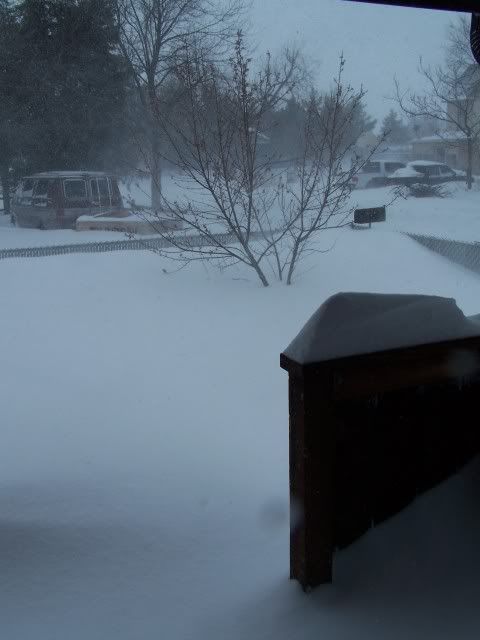 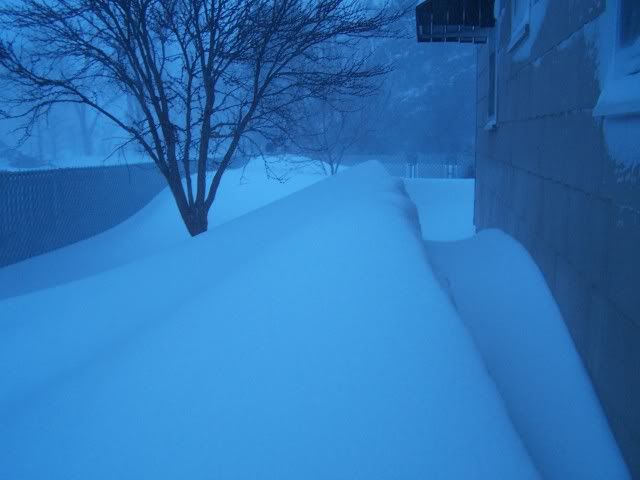  These were taken after an ice storm in December of 2007. Clayton decided to be born in the middle of this storm.   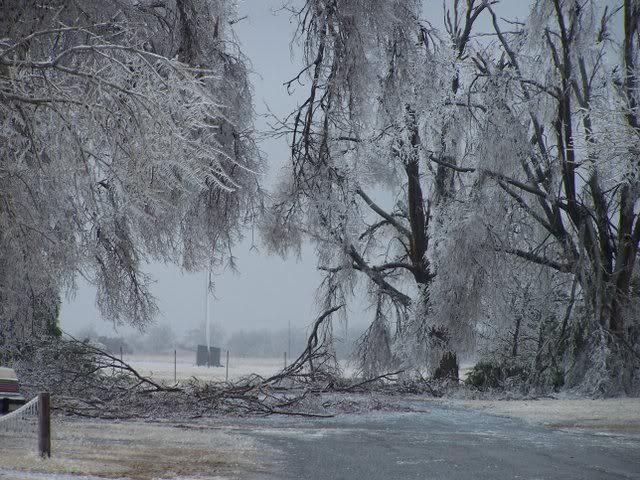  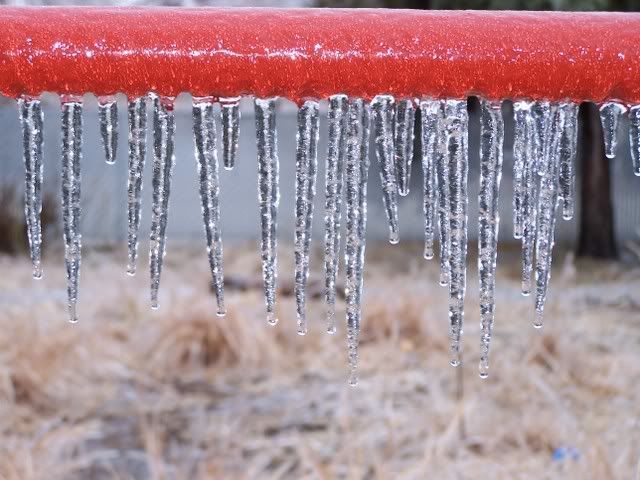 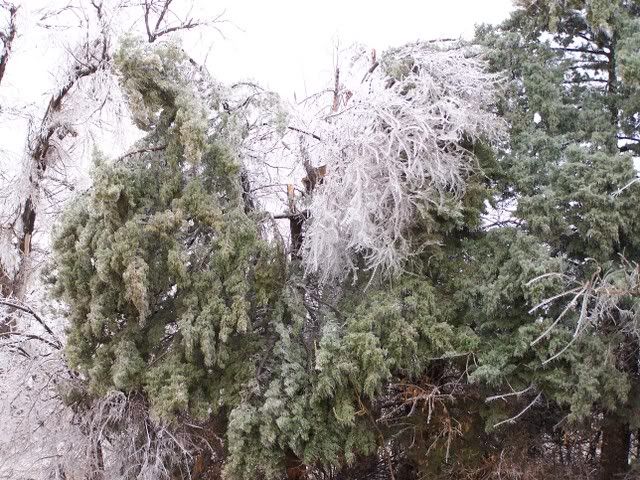 |
|